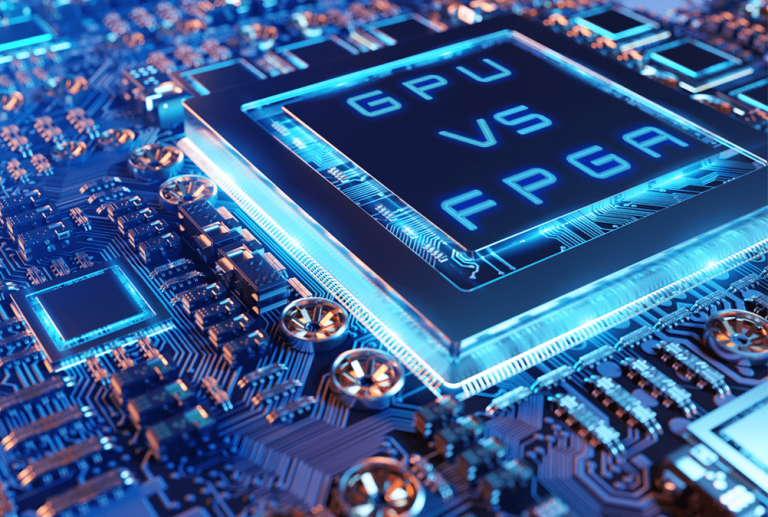Tech enthusiasts, buckle up! Field-Programmable Gate Arrays (FPGAs) and Graphics Processing Units (GPUs) are set to engage in an electrifying fight for supremacy in the realm of accelerated computing. Imagine a high-stakes fight where speed, agility, and raw power all clash.
In this epic battle, we will examine the distinctive advantages of FPGA and GPU designs, identify practical uses for them, and eventually assist you in the thrilling decision-making process. So get ready for a heart-pounding adventure as we explore the gripping FPGA versus GPU story. Decide on your champion now!
Understanding FPGA
An integrated circuit type known as a field-programmable gate array (FPGA) provides unmatched flexibility and reprogrammability for a variety of applications. FPGAs may be programmed and reprogrammed to perform a variety of purposes, unlike Application-specialized Integrated Circuits (ASICs), which are made for specialized jobs. As a result, they are extremely adaptable across a wide range of industries, including telecommunications, aerospace, automotive, and more.
FPGA Architecture and Functionality:
Configurable logic blocks (CLBs) are the building blocks of FPGAs, and they are coupled by programmable interconnects. Look-up tables (LUTs), flip-flops, and other parts are included in the CLBs and can be programmed to construct unique digital logic circuits. The interconnects allow for complicated designs by permitting signal routing between CLBs.
Advantages of FPGA:
a. Flexibility: FPGAs offer the ability to customize and modify the circuit design even after the device has been manufactured. This flexibility allows for quick iterations and adaptations to changing requirements.
b. Reprogrammability: Unlike ASICs, which are fixed and non-modifiable, FPGAs can be reprogrammed multiple times. This feature is particularly advantageous for prototyping, testing, and development stages.
c. Parallel Processing: FPGAs excel in parallel processing tasks, where multiple operations can be executed simultaneously, leading to significant speed improvements in specific applications.
d. Low Latency: FPGAs can achieve low-latency processing, making them suitable for real-time applications that require instantaneous responses.
Use Cases where FPGA Excels:
a. Image and Signal Processing: FPGAs can efficiently handle computationally intensive tasks like image and signal processing, where parallel processing and real-time performance are crucial.
b. Machine Learning and Artificial Intelligence: FPGA-based accelerators can enhance the performance of machine learning algorithms by offloading computationally intensive tasks, such as matrix operations and neural network computations, to dedicated hardware.
c. High-Frequency Trading: FPGA’s parallel processing capabilities enable rapid data analysis and decision-making, making them ideal for high-frequency trading systems that require low-latency processing.
Understanding GPU
GPUs are specialized hardware parts that were initially created for the purpose of generating visuals in video games and other computer graphics applications. However, they are becoming more and more well-liked for a variety of general-purpose computing jobs because of their excellent parallel processing capabilities. It is crucial to examine GPUs’ architecture and functionality in order to fully comprehend them and their capabilities.
Architecture of a GPU:
Streaming multiprocessors (SMs), also referred to as shader cores or CUDA cores, are the basic building blocks of a GPU. Multiple execution units that carry out arithmetic and logical operations are present in each SM.
An SM’s cores carry out operations in parallel, providing massively parallel computing capacity. Additionally, GPUs feature dedicated memory known as video RAM (VRAM), or graphics memory, which enables fast data access.
Functionality of a GPU:
A GPU’s main job is to carry out parallel computations on huge datasets. By spreading the workload across several cores, GPUs excel at handling repetitive and computationally difficult tasks, outpacing conventional central processing units (CPUs) by a wide margin.
For jobs involving matrix operations, image processing, simulation, deep learning, and other data-intensive applications, this parallel design is ideal.
Advantages of GPUs:
- Parallel Processing: GPUs can execute thousands of threads simultaneously, making them ideal for tasks that can be divided into smaller, independent computations.
- Performance: The massive parallelism of GPUs leads to substantial performance gains in applications that can leverage their processing capabilities.
- Graphics Rendering: GPUs are optimized for graphics rendering tasks, providing realistic and immersive visuals in games and multimedia applications.
- Deep Learning: GPUs have become the de facto standard for training and deploying deep neural networks due to their ability to handle the enormous computational demands of deep learning algorithms.
Use Cases for GPUs:
- Gaming and Multimedia: GPUs are essential for rendering realistic 3D graphics, enabling immersive gaming experiences and high-quality video playback.
- Data Science and Machine Learning: GPUs accelerate the training and inference processes in machine learning algorithms, enabling faster and more efficient model development.
- Scientific Computing: GPUs can significantly accelerate simulations, data analysis, and scientific computations in fields such as physics, biology, and chemistry.
- Cryptocurrency Mining: The parallel processing power of GPUs is utilized in mining cryptocurrencies like Bitcoin and Ethereum, where complex mathematical calculations are performed.
Performance Comparison: FPGA vs GPU
- Field-Programmable Gate Arrays (FPGAs) and Graphics Processing Units (GPUs) are frequently the two options when deciding on the best hardware for compute-intensive applications.
- Both FPGA and GPU provide substantial processing capacity and acceleration abilities, but their architectures and applicability for particular applications vary.
- To assist you in making a selection, we will examine the performance comparison between FPGA and GPU in this post.
1. Processing Power and Speed
- FPGAs are known for their capacity for parallel processing and the execution of numerous operations concurrently. They are perfect for particular applications that demand low-latency processing due to their highly adjustable nature, which enables customized hardware implementations.
- While massively parallel processing workloads are where GPUs shine. GPUs have a high throughput and are especially well-suited for tasks that require data parallelism since they have a large number of cores that are specialized for floating-point calculations.
2. Energy Efficiency and Power Consumption
- FPGAs are more energy-efficient than GPUs, which is a benefit. Compared to GPUs, FPGAs are made to be more energy-efficient and use less power, especially while carrying out tasks that are well suited to their architecture.
- GPUs tend to use more energy because of their numerous cores and fast clock speeds. It’s crucial to remember that the energy efficiency of both FPGA and GPU depends on the particular workload and the optimization strategies used.
3. Latency and Real-time Applications
- FPGAs excel in areas where real-time processing and minimal latency are essential. FPGA designs provide deterministic performance, enabling real-time response to input stimuli because they can be implemented at the hardware level.
- Because of this, FPGAs are perfect for applications like high-frequency trading, where split-second judgment is crucial. Due to their software-driven architecture, GPUs may introduce additional latency despite their high throughput capabilities, making them more suitable for applications with less pressing real-time requirements.
4. Application-specific Considerations
- The individual application requirements frequently determine whether to use an FPGA or a GPU. Since their parallelism and configurability allow for the efficient implementation of complicated algorithms, FPGAs are highly suited for applications involving image and signal processing.
- They also perform well in artificial intelligence and machine learning activities, especially when power usage and customization are important considerations.
- On the other hand, GPUs have achieved great success in gaming and graphics rendering thanks to their capacity for handling enormous volumes of concurrent data.
- They are also widely used in neural network training and deep learning, where the capacity to carry out matrix operations concurrently is crucial.
5. Cost Considerations
- Hardware selection is significantly influenced by the cost factor. Compared to GPUs, FPGAs often have greater upfront costs. FPGA programming and development might be more difficult, time-consuming tasks that need specific knowledge.
- On the other hand, GPUs provide a larger selection of development tools and a more user-friendly programming approach. Additionally, GPUs are more affordable for some applications because of economies of scale brought about by their broad adoption in the gaming and data science fields.
6. Scalability and Flexibility
- Considerations for long-term expansion and adaptability must include scalability and flexibility. FPGAs are very flexible because they can be instantly reprogrammed to meet changing demands.
- They are thus appropriate for applications that require regular upgrades or customization.
- While less reprogramming-friendly than CPUs, GPUs offer scalability by adding additional GPU units or using multi-GPU configurations to tackle heavier workloads.
Application-specific Considerations
- Choosing between FPGA and GPU involves considering the specific requirements and characteristics of the applications you intend to run.
- While both FPGA and GPU offer high-performance computing capabilities, certain applications are better suited for one technology over the other.
- Let’s explore the application-specific considerations for FPGA and GPU.
1. Types of applications that benefit from FPGA
- Image and signal processing: FPGA’s parallel processing architecture makes it ideal for applications such as image and signal processing, where real-time processing and low latency are crucial. FPGAs can efficiently handle complex algorithms and data-intensive operations, offering high throughput and deterministic performance.
- Machine learning and artificial intelligence: FPGAs can accelerate machine learning and AI workloads, especially for tasks like inferencing. With the ability to reconfigure hardware on the fly, FPGAs can adapt to evolving neural network architectures and enable highly optimized and power-efficient computations.
- High-frequency trading: FPGA’s ability to process large volumes of data and execute algorithms in real time is advantageous for high-frequency trading applications. FPGAs can provide ultra-low latency and deterministic performance, enabling traders to make split-second decisions and gain a competitive edge.
2. Types of applications that benefit from GPU
- Graphics rendering and gaming: GPUs are designed with a high degree of parallelism, making them highly suitable for graphics-intensive applications like rendering and gaming. GPUs excel at processing massive amounts of graphical data, delivering immersive visual experiences and real-time rendering capabilities.
- Deep learning and neural networks: Deep learning tasks, which often involve training large neural networks on vast amounts of data, greatly benefit from the parallel processing power of GPUs. GPUs can perform thousands of mathematical operations simultaneously, significantly reducing training times and enabling faster model convergence.
- Cryptocurrency mining: Mining cryptocurrencies like Bitcoin and Ethereum require extensive computational power for solving complex mathematical problems. GPUs, with their massively parallel processing capabilities, have been widely adopted for cryptocurrency mining due to their efficiency and cost-effectiveness compared to CPUs.
Cost Considerations
Cost is a crucial factor to consider when choosing between FPGA and GPU for your specific application. Here are some key cost considerations to keep in mind:
1. Initial Cost of FPGA and GPU Hardware:
- FPGA: Field-Programmable Gate Arrays tend to have a higher upfront cost compared to GPUs. FPGAs are specialized hardware devices that offer reprogrammability and flexibility, which comes at a premium.
- GPU: Graphics Processing Units are more commonly available and mass-produced, resulting in lower initial costs compared to FPGAs.
2. Development and Programming Costs:
- FPGA: Programming an FPGA requires specialized knowledge and skills, typically using hardware description languages like VHDL or Verilog. Designing and implementing FPGA-based solutions often involve additional development costs, including hiring FPGA experts or training existing personnel.
- GPU: Programming GPUs is relatively easier, as they are typically programmed using higher-level languages like CUDA or OpenCL. The development ecosystem for GPUs is more mature, with abundant resources, libraries, and community support.
3. Long-Term Maintenance and Upgrade Costs:
- FPGA: While FPGAs offer reprogrammability, they may require periodic updates or modifications to keep up with evolving requirements or technologies. These updates might involve additional costs, such as hiring FPGA experts or investing in new development tools.
- GPU: GPUs are generally replaced or upgraded as new models with improved performance are released. Long-term maintenance costs may involve upgrading to newer GPU models or investing in software updates to ensure compatibility with the latest frameworks or libraries.
Conclusion
In conclusion, the choice between FPGA and GPU depends on various factors such as the nature of the application, performance requirements, cost considerations, programming ecosystem, scalability, and flexibility. Both FPGA and GPU have their strengths and weaknesses, making it essential to evaluate the specific needs of the project before making a decision.
FPGAs offer unparalleled flexibility and reprogrammability, making them ideal for applications that require customization and frequent updates. They excel in tasks involving image and signal processing, machine learning, and high-frequency trading, where the ability to implement specialized algorithms and parallelize computations is crucial.
On the other hand, GPUs are designed for high-performance parallel processing. They shine in applications like graphics rendering, gaming, deep learning, and neural networks, where massive amounts of data need to be processed simultaneously. GPUs provide significant speed advantages and are well-suited for computationally intensive tasks.
In conclusion, the decision to choose FPGA or GPU involves a careful assessment of performance needs, cost considerations, programming ecosystem, scalability, and flexibility requirements. Understanding the strengths and weaknesses of each technology will empower developers to make an informed choice that aligns with the unique demands of their project, ultimately leading to optimal performance and successful implementation.


![What is FPGA Introduction to FPGA Basics [2023] computer-chip-dark-background-with-word-intel-it](https://fpgainsights.com/wp-content/uploads/2023/06/computer-chip-dark-background-with-word-intel-it-300x171.jpg)









